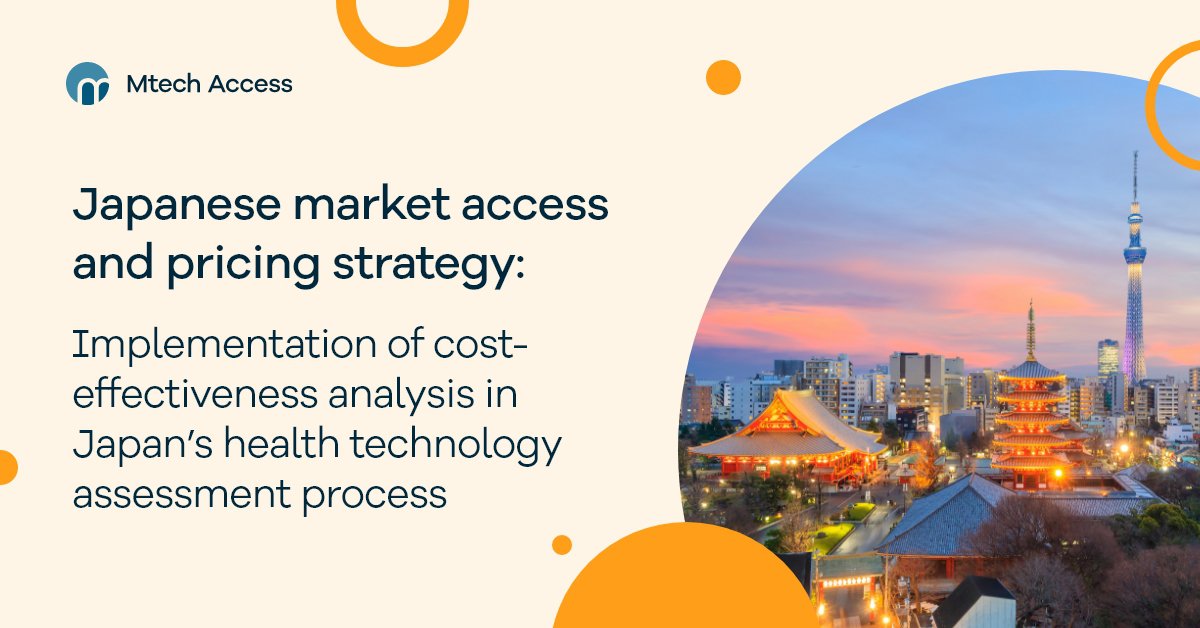
In April 2019 a new route to reimbursement in Japan was formally implemented. It requires certain new medicines and medical devices to undergo a cost-effectiveness analysis, effectively adding an additional market access hurdle for this subset of products.
Here, Heather Wellam (Senior Consultant – Market Access) explains the cost-effectiveness analysis process and explores the challenges and opportunities that the new route offers for those looking to achieve market access in Japan:
- 5 quick questions answered on the cost-effectiveness process in Japan
- How we got here – the history of cost-effectiveness analysis in Japan
- Where we are now – the new route to reimbursement
- The detail – calculating drug prices in Japan
- Challenges and opportunities
5 FAQs on the new cost-effectiveness process in Japan
1) Who conducts the assessment of the cost-effectiveness analysis (CEA)?
The Center for Outcomes Research and Economic Evaluation for Health (C2H) (1).
2) What is the aim of the CEA assessment?
To reduce expenditure and increase efficiency within the healthcare system by using cost-effectiveness analyses to evaluate the appropriateness of the price set by Chuikyo and, depending on the outcome of the assessment, to apply an upward or downward price adjustment (1).
3) What is the timeline?
If applicable, the assessment is conducted after a drug is listed on the National Health Insurance (NHI) drug standard. Selected manufacturers must submit a CEA to the C2H within 9 months, and the C2H takes approximately 6 months to complete their review. The total timeline is approximately 15 months (2).
4) What is the methodology?
The CEA system is based on the incremental cost-effectiveness ratio (ICER); costs per quality-adjusted life year (QALY) gained. See more.
C2H have published guidelines for manufacturers to support their CEA submission. For example, how to define the perspective, target population, comparator, and benefits. The guidelines also outline specific direction on methods for analysis, including calculating the ICER, determining time horizon, choice of outcome measure, appropriate sources of clinical data, calculation of healthcare costs, productivity loss, discounting, modelling, and handling uncertainty (3).
5) How is the price adjusted after assessment?
Price adjustment rates are based on stepwise ICER thresholds and are applied to the launch premiums (if applicable) and to the operating profit portion of the NHI list price (jump to Calculating drug prices in Japan).
The history of CEAs in Japan
In Japan, CEAs for the purpose of public drug listing have been permitted by the Ministry of Health, Labour, and Welfare (MHLW) since 1992. However, the data submission was voluntary, with little guidance given. As the data did not influence medicine pricing or listing, few pharmaceutical manufacturers submitted a CEA (1).
In 2012, the National Institute of Public Health (NIPH) founded a new committee called the Center for Outcomes Research and Economic Evaluation for Health (C2H). In 2016 this new committee brought in mandatory CEAs on a trial basis for a small number of products.
After a series of consultations to refine the methodology, a consensus was reached, and a new CEA process was formally implemented in April 2019 (1).
CEA – the new route to reimbursement in Japan
For selected products, the new CEA process adds several additional steps to achieve market access. In addition to the standard process demonstrated in steps 1 and 2 below, selected products are required to complete steps 3–6 before their price is finalised.

Abbreviations: CEA, cost-effectiveness analysis; C2H, Center for Outcomes Research and Economic Evaluation for Health; NHI, National Health Insurance; PMDA, Pharmaceuticals and Medical Device Agency.
Step 1:
A new product entering the Japanese market must first gain marketing authorisation from the Pharmaceuticals and Medical Device Agency (PMDA).
Step 2:
Following marketing authorisation, pharmaceutical companies must next apply to the Central Social Insurance Medical Council (Chuikyo) to be listed on the NHI drug standard. The NHI drug standard lists the prices of drugs that are publicly reimbursed by the MHLW.
The reimbursed drug price is determined using one of two different pricing algorithms, the ‘similar efficacy comparison method’ or the ‘cost calculation (cost plus) method’. Premiums are also applied, in certain circumstances. Jump to Calculating drug prices in Japan for more detail.
Once the product has been listed on the NHI drug price standard, it is reimbursed under the public insurance-covered healthcare system. Historically, this was the full reimbursement process, and for some products this is still the final hurdle to reimbursement.
However, since the inauguration of the new CEA system in 2019, there are now additional market access hurdles for a subset of products.
Step 3:
Chuikyo then selects certain medicines and medical devices for cost-effectiveness analysis. Products are selected for assessment using a five-tier classification system. This is principally based on predicted annual peak sales and degree of innovation (premium). Products for rare diseases, haemophilia and human immunodeficiency virus (HIV) are excluded. See Table 1 below:

Step 4:
If a product is selected, then the pharmaceutical or medical device company must prepare a CEA. A reputable market access and HEOR consultancy, like Mtech Access, are often best equipped to support companies with this step.
Step 5:
The CEA is submitted to C2H for review and appraisal.
Step 6:
Chuikyo use this assessment to re-evaluate and, if necessary, adjust the NHI standard list price.
Calculating Drug Prices in Japan
When there is a comparable drug with the same indication, the ‘similar efficacy comparison method’ is used. Here the daily drug price of the new drug is matched to the daily drug price of the existing drug to ensure fair competition. If the new drug is evaluated as ‘superior’ then a premium may be awarded.

There are premiums for innovation, usefulness, marketability, paediatric indications and treatment of severe illness (See Table 2).
When there is not a comparable drug with the same indication, the ‘Cost calculation (cost plus) method’ is used. Here, production costs, administrative costs, overheads, and operating profit are summed to determine a reimbursed price.

Once again, premiums are awarded if the drug is proven to be highly useful, as outlined in Table 2 below:

Japan is the first market to use a stepwise ICER criteria for determining the re-pricing rates.

Abbreviations: QALY, quality-adjusted life year.
Some analysts have asked whether the ICER cut-offs of JPY 5million/QALY, JPY 5–7.5million/QALY, JPY 7.5–10million/QALY and JPY 10 million/QALY are appropriate.
The values were based on historic willingness-to-pay (WTP) surveys, and some challenge whether WTP is the most appropriate metric. Interestingly, the JPY 5 million threshold is higher than the threshold set by UK’s NICE (£20,000), but lower than the US ICER ($50,000).
Challenges and opportunities with the CEA
For the subset of products that are selected for assessment, the development of a CEA is an additional hurdle to Japanese market access and may result in delays or barriers to patients receiving access to new interventions. Firstly, companies will need to assess whether their product will be selected to undergo a CEA. Next, they must ensure that all the relevant domestic inputs are available, and that they invest in the internal capabilities to submit the analysis in line with MHLW requirements.
Acquiring higher premiums through the Chuikyo pricing methodology has been a longstanding challenge for companies launching in Japan. The new system applies an increased pricing pressure and a risk of downward list price adjustment shortly after launch. The possibility of losing up to 90% of the drug premium and 50% of the operating profit within 1.5 years of launch undermines the innovation and usefulness reward and may make Japan a less attractive market to manufacturers.
The repricing system is also anticipated to have a wider impact on the competitive set, with similar pricing adjustments expected to be applied.
Some critics of the system suggest that the system has an over-reliance on the ICER and that other important factors are being overlooked. For example, disease severity, unmet therapeutic need, patient convenience, and societal impact.
The Japanese CEA system is in its infancy, and is likely to evolve, either through an expansion of the scope of products assessed or in its potential remit. For example, if the CEA system was used in the future to determine reimbursement, this would create inevitable delays in the listing of a new product and will require more consideration from manufacturers of their launch priorities.
Support from Mtech Access
If you’re looking for insight and strategic advice on market access and reimbursement strategy across different markets, we can help. Email info@mtechaccess.co.uk to begin exploring your target markets with our global market access experts.
References
- Health NIoP. Application of cost-effectiveness in Japan. C2HSeptember 2022.
- Health NIoP. Roles of C2H in cost-effectiveness evaluation 2022.
- Health C. Guidelines for Preparing Cost Effectiveness Evaluation to the Central Social Insurance Medical Council version 30.0. CSIMC, 2022.


